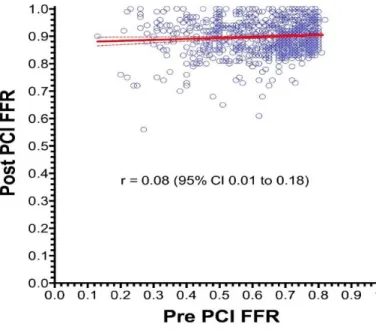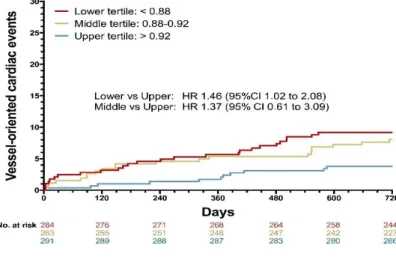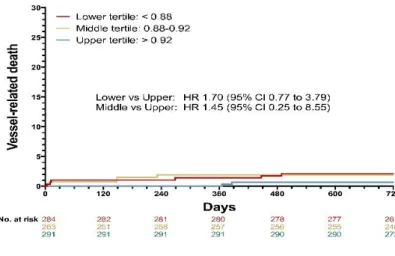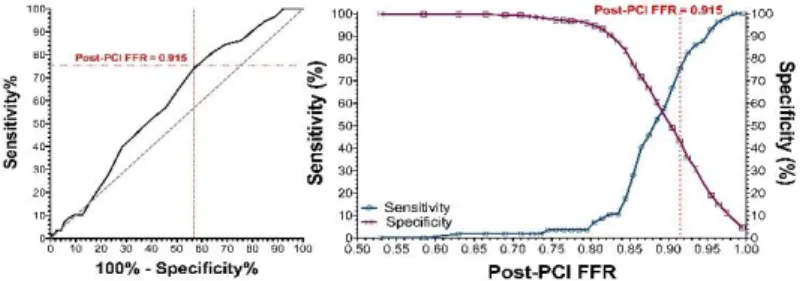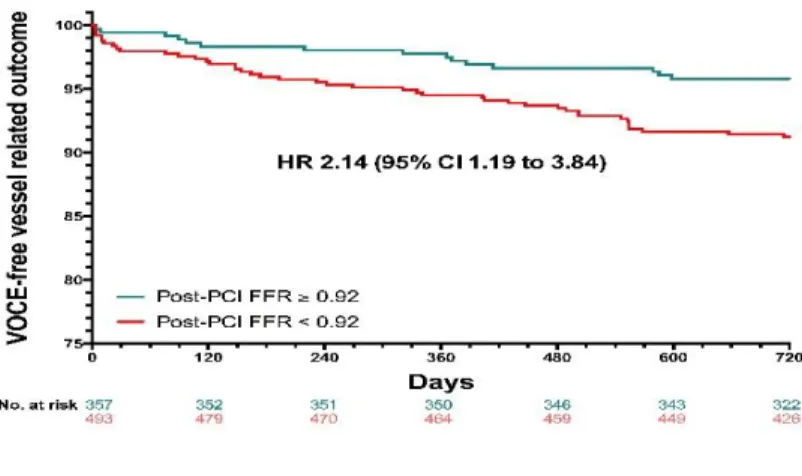Clinical application of post-PCI FFR
PhD thesis
Zsolt Piróth
Clinical Medicine Doctoral School Semmelweis University
Supervisor: Péter Andréka, MD, PhD Official reviewers: András Komócsi, MD, DSc
Dániel Aradi, MD, PhD
Head of the Final Examination Committee: Zoltán Benyó, MD, DSc Members of the Final Examination Committee: Barna Vásárhelyi, MD, DSc
András Folyovich, MD, PhD Tivadar Tulassay, MD, DSc
Budapest
2018
1 Introduction
As a major paradigm shift over the past years, the strategy of myocardial revascularization has been based on functional rather than solely morphological parameters. Albeit coronary angiography remains the reference method to diagnose coronary artery disease, the relationship between the morphologic severity of disease and the prognosis remains loose. One of the key determinants of the prognosis of coronary artery disease is the amount of inducible ischaemia. Fractional Flow Reserve (FFR) has proven to be the most precise method to determine the presence or absence of ischaemia induced by individual stenoses. Based on the DEFER, FAME and FAME 2 trials, FFR is superior to angiography in selecting target lesions of revascularization: both the identification of stenoses to be treated for symptomatic or prognostic benefit and the deferral of revascularization are more precise by FFR, and an FFR- based treatment strategy is cost-effective and sometimes cost- saving as compared with an angiography-based one. FFR is not only a qualitative but a quantitative measure. In non- revascularized patients, the functional severity of coronary artery disease as measured by FFR is proven to correlate closely with the prognosis. It was also shown that FFR measured immediately after bare metal stenting has a prognostic value:
the lower it is, the higher is the major adverse cardiovascular
2
event rate. However, there is no convincing proof that post-PCI FFR has the same prognostic value when measured immediately after implanting modern drug-eluting stents (DES).
Aim
The aim of the present thesis was to investigate the potential of FFR measured immediately after DES implantation to predict the 2-year Vessel-Oriented Composite Endpoint (VOCE) rate.
VOCE was defined as a composite of vessel-related cardiovascular death, vessel-related spontaneous myocardial infarction and ischaemia-driven target vessel revascularization (TVR). We also aimed to define the post-PCI FFR cut-off value to predict VOCE.
Methods
The patient population comprises those who had post-PCI FFR measurement in the FFR-guided arm of FAME and in the PCI arm of FAME 2 studies. Since obtaining post-PCI FFR was not mandated in the above studies, not all patients from these two arms are included in the present analysis.
The relationship between post-PCI FFR and 2-year clinical outcome is analysed on a vessel level. In accordance with the protocol of FAME and FAME 2 studies, percent diameter
3
stenosis (DS) by visual estimation is reported in the following strata: <50%, 50-69%, 70-90%, >90%.
The primary endpoint of the present study is the Vessel- Oriented Composite Endpoint at 2 years, defined as the composite of vessel-related cardiovascular death, vessel- related, spontaneous (i.e. non-periprocedural) myocardial infarction and ischaemia-driven target vessel revascularization (both urgent and non-urgent). In both FAME and FAME 2, an independent Clinical Event Committee (CEC) blinded to the randomization allocation adjudicated all adverse events. The present analysis is based on events adjudicated by the CEC’s.
The original narratives filed by the investigators were reviewed and evaluated independently by two interventional cardiologists (Zsolt Piróth MD and Gábor Gayor Tóth MD) blinded to the baseline clinical and angiographic characteristics as well as to the post-PCI FFR value. Events were classified as vessel-related or non-vessel-related. In case of disagreement, the narrative was reviewed again until a consensus was achieved. Death was categorized as either cardiovascular or non-cardiovascular. Any death of unknown cause was counted as cardiovascular.
Cardiovascular death in patients with multiple index stenoses was assigned to each index vessel. Any spontaneous myocardial infarction without a clearly identifiable culprit lesion in patients
4
with multiple index vessels was assigned to all index vessels. In conclusion, clearly non-cardiovascular death, a periprocedural or spontaneous but clearly non-index vessel-related myocardial infarction was not counted.
Continuous variables are reported as mean ± standard deviation (SD) or median and interquartile range (between 25th and 75th percentile), categorical data are presented as numbers or percentages, as appropriate. Normal distribution was tested with D’Agostino K2 test. Comparisons between continuous variables were performed using Student t test or Mann-Whitney test, as appropriate. Comparisons between categorical variables were performed using Pearson Chi2 or Fisher exact test, as appropriate.
Sensitivity, specificity and optimal diagnostic cut-off values were defined from the calculated receiver-operating characteristic (ROC) curves, as appropriate. In analysis of time- to-event outcomes, Cox regression was used with robust SE to account for the correlation between the lesions. The added predictive value of the new predictor (baseline FFR) over and above a reference model (post-PCI FFR) was assessed by integrated discrimination improvement index based on a logistic model. Kaplan-Meier curves were constructed for the primary end point of VOCE at 2-year follow-up. Two sided P
5
values are reported throughout and P values smaller than 0.05 were considered as statistically significant. Analyses were performed with Prism GraphPad 5.0 (GraphPad Software Inc, CA), SPSS 20.0 (IBM Inc, New York) and Strata 14.0 (Strata Corp, College Station, Tx).
Results
Of the 509 patients in FAME trial randomized to FFR-guidance, 352 (69.2%) had post-PCI FFR measurement immediately after the index PCI. Of the 447 patients in FAME 2 trial randomized to PCI, 287 (64.2%) had post-PCI FFR measurement. Together, these 639 patients constitute the study group of the present analysis. In these 639 patients, 838 vessels were evaluated by post-PCI FFR measurement. Of the 838 vessels, 433 (51.7%) were left anterior descending arteries (LAD), 217 (25.9%) were right coronary arteries (RCA) and 188 (22.4%) were circumflex arteries (Cx). The median pre-PCI (baseline) FFR was 0.68 (0.54-0.74): 0.69 (0.58-0.75) in the LAD, 0.66 (0.50-0.74) in the Cx, and 0.64 (0.50-0.74) in the RCA. The median value of post-PCI FFR was 0.90 (0.86-0.94). Importantly, no relationship was found between baseline and post-PCI FFR values. This is shown by Figure 1.
6
Figure 1. Relationship between pre-PCI FFR and post-PCI FFR By computing standardized coefficient in multiple regression analysis, male gender, diabetes mellitus and LAD location were found to be significant predictors of a lower post-PCI FFR value, whereas implanting multiple stents in the given vessel showed a strong trend to predict a lower post-PCI FFR value.
Higher baseline diameter stenosis and higher pre-PCI FFR predict higher post-PCI FFR. Comparison between the extended (post-PCI FFR + baseline FFR) and reference (post- PCI FFR alone) models show that there is a small difference
7
between their predictive ability (integrated discrimination improvement = 0.00565; z=2.53, P=0.012).
Complete follow-up was obtained in 93.8% of the patients. The mean length of follow-up was 23.6 ± 2.8 months (time to censored event between 0 and 24 months). Altogether, 69 events were detected in 58 treated vessels (6.9%).
Baseline FFR values did not differ between vessels with versus without VOCE (0.66; 95% confidence interval [CI], 0.63–0.69 versus 0.63; 95% CI, 0.62–0.64, respectively; P=0.207). Post- PCI FFR was significantly lower in vessels with VOCE during follow-up (0.88; 95% CI, 0.87–0.90 versus 0.90; 95% CI, 0.89–
0.90, respectively; P=0.019).
When grouping the vessels in tertiles according to the post-PCI FFR value (<0.88 versus 0.88–0.92 versus >0.92), a significant difference was found in the rate of VOCE with lowest incidence in the upper tertile (9.2% versus 7.9% versus 3.8%, respectively; P=0.029).
Comparing the 2-year outcome of lower and upper tertiles of post-PCI FFR, a significant difference was found favouring the upper tertile in terms of overall VOCE (9.2% versus 3.8%, respectively; hazard ratio [HR], 1.46; 95% CI, 1.02–2.08;
P=0.037) and TVR (7.0% versus 2.4%, respectively; HR, 1.59;
8
95% CI, 1.03–2.46; P=0.037). No difference was found in vessel-related spontaneous MI or in vessel-related mortality.
Comparing the 2-year outcome of the middle and upper tertiles of post-PCI FFR, no significant difference was found in overall VOCE, TVR, spontaneous MI, or vessel-related mortality (Figures 2-5).
When adjusted to sex, hypertension, diabetes mellitus, target vessel, serial stenosis, and baseline percent DS, a strong trend was preserved in terms of TVR (HR, 1.55; 95% CI, 0.97–2.46;
P=0.066) favouring the upper tertile compared with the lower.
Figure 2. VOCE (Vessel-Oriented Composite Endpoint) rates in the lower, middle and upper tertiles
9
Figure 3. Vessel-related death in the lower, middle and upper tertiles
Figure 4. Vessel-related spontaneous myocardial infarction in the lower, middle and upper tertiles
10
Figure 5. Target vessel revascularization in the lower, middle and upper tertiles
Receiver–operating characteristic curve analysis was performed to identify a potential cut-off with prognostic value for VOCE during 2-year follow-up (Figure 6).
Figure 6. Definition of a potential cut-off value of post-PCI FFR predicting Vessel-Oriented Composite Endpoint at 2-year follow-up.
11
Post-PCI FFR <0.92 has the highest Youden index.
Accordingly, when comparing the 2-year outcome of vessels with post-PCI FFR <0.92 and vessels with post-PCI FFR ≥0.92, a significant difference was found in terms of overall VOCE (8.7% versus 4.2%, respectively; HR, 2.14; 95% CI, 1.19–3.84;
P=0.011). The difference remained significant even after adjusting for sex, diabetes mellitus, target vessel, baseline percent DS, and use of first-generation DES (HR, 1.87; 95% CI, 1.01–3.46; P=0.045).
Differences in 2-year VOCE-free survival between vessels with a post-PCI FFR value of less than 0.92 as compared with at least 0.92 are shown in Figure 7.
Figure 7. 2-year VOCE-free survival
12
The significant difference in the 2-year VOCE between the two groups is caused by the difference in target vessel revascularization, no significant difference was found in terms of vessel-related deaths or vessel-related myocardial infarctions.
Yet, sensitivity and specificity of this 0.92 post-PCI FFR cut- off value to predict vessel-related events are low: 75.4% (95%
CI, 62.2–85.9) and 43.3% (95% CI, 39.8–46.8), respectively.
Accordingly, no post-PCI FFR value was found to have a HR
>1.5 for VOCE at 2 years.
Conclusions
In the present thesis, the relationship between the FFR value measured immediately after DES implantation and the vessel- related untoward events was investigated. The main findings are the following:
1. Vessels with a lower post-PCI FFR value after at least one DES implantation are associated with more adverse clinical events as compared with vessels with a higher post-PCI FFR value during two years of follow-up. The difference was preserved as a strong trend even after adjustment for various clinical, angiographic, and procedural characteristics shown to influence the post-PCI FFR value.
13
Therefore, these findings extend the overall prognostic value of FFR to post-PCI measurements – on a population level.
2. Male sex, diabetes mellitus and LAD lesion location are associated with a lower post-PCI FFR achieved after angiographically successful revascularization. Implanting multiple stents in the given vessel showed a strong trend to predict a lower post-PCI FFR value. Higher baseline diameter stenosis and higher pre-PCI FFR predict higher post-PCI FFR.
3. Nevertheless, the low hazard ratio, sensitivity and specificity found in this study indicate that there is no discrete post-PCI FFR value that could be proposed to rule in or rule out vessel-oriented adverse events. Accordingly, post-PCI FFR cannot be advocated as a clinical surrogate nor as a guide for PCI optimization.
The clinical question remaining is how much clinical benefit can be expected from further interventions to optimize the post- PCI FFR. One must not forget that postdilatation can potentially increase the trauma suffered by the vessel wall, and further stent implantation can increase the risk of in-stent restenosis and potentially stent thrombosis. These have to be taken into consideration when contemplating further PCI with a view to
14
increase post-PCI FFR. Needless to say, this question can only be answered by an adequately powered randomized clinical trial.
It is important to stress that in this study the post-PCI values were merely documentary because, after angiographically successful PCI, according to protocol, no additional manoeuver was undertaken to achieve a higher FFR value. However, the reported post-PCI FFR values are in line with previous reports, therefore our conclusions are generalizable. Second, patients and their treating physicians could be aware of the post-PCI FFR value. However, all patients had angiographically successful PCI, and the vast majority had a nonsignificant FFR on completion of the intervention, therefore it is highly improbable that this could influence further events (including revascularization). Third, albeit measurement of post-PCI FFR was recommended in the trials, it was performed only in two thirds of all cases, suggesting some selection bias. Fourth, we did not specifically investigate the effect of medical therapy and compliance of patients with the medical regimen; however, both trials mandated optimal medical therapy, and the FAME 2 trial reported on the medical therapy of the different arms of the trial.
Fifth, because post-PCI pullback recording during constant hyperaemia was not mandated, we are unable to tell whether a
15
suboptimal post-PCI FFR value is a result of residual diffuse coronary atherosclerosis, imperfect stenting, or pressure drift.
However, routine “pullback recording” is generally not performed in clinical practice. Sixth, the angiographic severity of lesions and the success of the PCI were determined by the visual estimate (“eyeballing”) of the FAME and FAME 2 investigators, no independent “core-lab” analysis was performed, but again this is in line with present-day practice.
And finally, one may suspect that the differences were driven by the fact that in FAME, first generation DES were used whereas in FAME 2, modern, second generation DES were implanted. However, significantly more first generation DES were implanted in vessels with a high (≥ 0.92) as compared with a low (<0.92) post-PCI FFR value.
In conclusion, we were able to prove that post-PCI FFR measurement after DES implantation has a prognostic value on a population level, however its application in individual decision making remains questionable.
16
List of the candidate’s publications related to the thesis 1. Piroth Z*, Toth GG*, Tonino PAL, Barbato E, Aghlmandi
S, Curzen N, Rioufol G, Pijls NHJ, Fearon WF, Jüni P, De Bruyne B. (2017) Prognostic Value of Fractional Flow Reserve Measured Immediately After Drug-Eluting Stent Implantation. Circ Cardiovasc Interv, 10: e005233. DOI:
10.1161/CIRCINTERVENTIONS.116.005233.
IF: 6,598
2. Piroth Z, Ferenci T, Fontos G, Szonyi T, Nemeth J, Szoke S, Chaurasia AK, Andreka P. (2016) Five-year outcome of consecutive unprotected left main percutaneous coronary interventions. Acta Cardiol, 71: 654-662.
IF: 0,808
3. Piróth Z. (2014) Percutan coronariaintervenció stabil coronariabetegségben. Orv. Hetil, 159: 1952-1959.
4. Piróth Z. (2015) A fractionalis flow reserve – múlt, jelen, jövő. Minimal Invasive Therapy, May: 31-35.
5. Piroth Z. (2018) FFR in everyday use: the case of left ventricular dysfunction. J Card Disord Therapy, 1: 102.
6. De Bruyne B, Pijls NH, Kalesan B, Barbato E, Tonino PA, Piroth Z, Jagic N, Möbius-Winkler S, Rioufol G, Witt N, Kala P, MacCarthy P, Engstrøm T, Oldroyd KG, Mavromatis K, Manoharan G, Verlee P, Frobert O, Curzen N, Johnson JB, Jüni P, Fearon WF; FAME 2 Trial
17
Investigators. (2012) Fractional flow reserve-guided PCI versus medical therapy in stable coronary disease. N Engl J Med, 367: 991-1001.
IF: 51,658
7. De Bruyne B, Fearon WF, Pijls NH, Barbato E, Tonino P, Piroth Z, Jagic N, Mobius-Winckler S, Rioufol G, Witt N, Kala P, MacCarthy P, Engstrøm T, Oldroyd K, Mavromatis K, Manoharan G, Verlee P, Frobert O, Curzen N, Johnson JB, Limacher A, Nüesch E, Jüni P; FAME 2 Trial Investigators. (2014) Fractional flow reserve-guided PCI for stable coronary artery disease. N Engl J Med, 371: 1208- 1217.
IF: 55,873
8. Barbato E, Toth GG, Johnson NP, Pijls NHJ, Fearon WF, Tonino PA, Curzen N, Piroth Z, Rioufol G, Jüni P, De Bruyne B. (2016) A Prospective Natural History Study of Coronary Atherosclerosis Using Fractional Flow Reserve. J Am Coll Cardiol, 68: 2247-2255
IF: 19,896
9. Smits PC, Abdel-Wahab M, Neumann FJ, Boxma-de Klerk BM, Lunde K, Schotborgh CE, Piroth Z, Horak D, Wlodarczak A, Ong PJ, Hambrecht R, Angerås O, Richardt G, Omerovic E; Compare-Acute Investigators. (2017)
18
Fractional Flow Reserve-Guided Multivessel Angioplasty in Myocardial Infarction. N Engl J Med, 376: 1234-1244.
IF: 72,406
10. Rimac G. Fearon WF, De Bruyne B, Ikeno F, Matsuo H, Piroth Z, Costerousse O, Bertrand OF. (2017) Clinical value of post–percutaneous coronary intervention fractional flow reserve value: A systematic review and meta-analysis.
Am Heart J, 183: 1-9.
IF: 4,436
List of the candidate’s publications unrelated to the thesis 1. Piróth Z. (2015) Akut mellkasi fájdalom. Medicina
Thoracalis, 68: 185-192.
2. Piróth Z. (2014) Az akut koronária szindróma diagnosztikája. Metabolizmus, 12: G5-7.
3. Kovács LG, Nyolczas N, Habon T, Sepp R, Piróth Z, Hajas Á, Boncz I, Tomcsányi J, Kappelmayer J, Merkely B.
(2015) Natriureticus peptidek mérése szívelégtelen betegekben: a helyes laboratóriumi és klinikai gyakorlat.
Orv. Hetil, 156: 1235-1245.
4. Piróth Z. Intenzív észlelés és kezelés a kardiológiában. In:
Keltai M. (szerk.), Kardiológia. Semmelweis Kiadó, Budapest, 2006: 143-151
19
5. Piróth Z, Andréka P. A thrombocyta aggregatio gátlás és az anticoagulans kezelés perioperatív vezetése. In:
Barankay A, Darvas K, Szabolcs Z.
(szerk.), Szív- és érbetegségek perioperatív ellátása.
Semmelweis Kiadó Bp. 2009: 325- 337.
